Electronics News
Archive : 20 September 2015 год
 The Dual Use Technology Exploitation (DUTE) cluster is a £10million project jointly funded between government and industry aiming to back technologies and research which can have a ‘dual use’ in defence and civil sector businesses.
The Dual Use Technology Exploitation (DUTE) cluster is a £10million project jointly funded between government and industry aiming to back technologies and research which can have a ‘dual use’ in defence and civil sector businesses.
The project will help boost growth by linking UK manufacturers, particularly SMEs, from the civil and defence sectors to draw on the best technologies of both to deliver game-changing solutions for customers.
DUTE is an output from the Defence Growth Partnership’s Value Chain Competitiveness Team which is chaired by Steve Fitz-Gerald, CEO of Marshall Aerospace and Defence Group. Marshall leads the 15-partner cluster, supported by Axillium Research, which includes SMEs, Mid-Tier and Primes from industry working alongside academic institutions.
It has been created to identify and leverage technologies from adjacent sectors such as rail and civil aerospace, and put them to dual use. It harnesses the UK’s community of SMEs, recognising the trend for greater investment in the civil domain, and augments it as a way to stimulate growth for defence exports.
Through DUTE, cross-sector fertilisation of thought and development will generate disruptive technologies for customers. Supported by an Innovation Cluster, there is a strong focus on connecting UK manufacturers with high-growth SMEs and technology start-ups, with the Cluster providing mentoring and technology showcasing opportunities as well as engendering innovation.
The £10.3m project includes £6.5m of government funding from the Advanced Manufacturing Supply Chain Initiative 2014 competition and will create 142 new jobs, safeguarding a further 192.
Pic: Steve Fitz-Gerald, CEO of Marshall Aerospace and Defence Group
Author
Tom Austin-Morgan
Source: www.newelectronics.co.uk
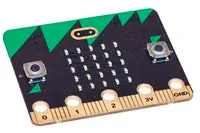 The BBC has announced its micro:bit computer, due to be given to one million schoolchildren in October to boost interest in coding, has been delayed. An issue with its power supply means it will now be sent out after Christmas.
The BBC has announced its micro:bit computer, due to be given to one million schoolchildren in October to boost interest in coding, has been delayed. An issue with its power supply means it will now be sent out after Christmas.
The pocket-sized codeable computer is the BBC's most ambitious education initiative for 30 years. In the 1980s, the BBC launched the Micro, which introduced many children to computing. The BBC hopes the Micro Bit will equip a new generation with the digital skills they need to find jobs and help grow the UK economy as the UK is facing a skills shortage in the technology sector.
The problem is said to have affected a small number of devices, but the priority was making sure it was as robust and reliable as possible. "We're expecting to start sending them out to teachers before Christmas and to children early in the New Year," a BBC spokesman said.
Author
Tom Austin-Morgan
Source: www.newelectronics.co.uk
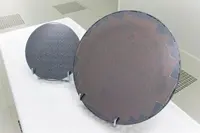 CEA-Leti claims to have manufactured micro-accelerometers on 300mm wafers, a development that could lead to lower MEMS manufacturing costs.
CEA-Leti claims to have manufactured micro-accelerometers on 300mm wafers, a development that could lead to lower MEMS manufacturing costs.
“This demonstration that our 200mm MEMS platform is now compatible with 300mm wafer fabrication shows a significant opportunity to cut MEMS production costs,” said Leti CEO Marie Semeria. “This will be especially important with the worldwide expansion of the IoT and continued growing demand for MEMS in mobile devices.”
Leti’s M&NEMS technology platform is based on detection by piezo-resistive silicon nanowires, which reduce sensor size and improve performances of multi-axis sensors. Its inertial-sensor manufacturing concept enables the design and fabrication of combo sensors, such as three-axis accelerometers, three-axis gyroscopes and three-axis magnetometers on the same chip;a key component for IoT applications.
Leti’s M&NEMS concept, developed with 200mm technology, is currently being transferred to an industrial partner. Demonstration of this technology on 300mm wafers is said to have shown very promising results.
In addition to lowering costs, manufacturing MEMS with 300mm technology enables 3D integration using MEMS CMOS processes in more advanced nodes than on 200mm, and the use of 3D through-silicon-vias, which is already available in 300mm technology.
Pic: 200mm and 300mm M&NEMS wafers
Author
Tom Austin-Morgan
Source: www.newelectronics.co.uk
 The LUTZ Pathfinder, the first of three electric-powered ‘pod’ vehicles, was unveiled outside Milton Keynes Central train station as part of a project to trial automated vehicles in pedestrianised areas.
The LUTZ Pathfinder, the first of three electric-powered ‘pod’ vehicles, was unveiled outside Milton Keynes Central train station as part of a project to trial automated vehicles in pedestrianised areas.
The event marked the completion of the first project vehicle by Coventry-based manufacturers RDM Group. The two-seater pod was then delivered to Oxford University’s Mobile Robotics Group (MRG) to begin the installation of the pod’s autonomous control system.
Following the installation work, the pod will undergo a series of calibration tests at a private test track before returning to Milton Keynes for the start of the public trials. At that stage, the pods will be the first fully automated vehicles to be trialled on public pedestrianised areas in the UK.
“This was a very exciting day for everybody involved in the LUTZ Pathfinder project, because it signals the completion of the manufacturing phase and the effective start of the autonomous technology trial,” said Transport Systems Catapult CEO Steve Yianni.
“When you consider that there wasn’t even a design in place for this vehicle less than 18 months ago, it has been a really quick turnaround to now have our first research vehicle ready to start work, and this has only been possible as a result of our successful collaboration with RDM, MRG and Milton Keynes Council.”
The pods will operate in autonomous mode, with a trained operator remaining in each pod to take back control of the vehicle if necessary. The pods will have a maximum speed of 15mph but will be limited electronically depending upon the environment they are travelling in.
“Safety has been our paramount concern throughout the planning process, which is why we will continue to have a human operator at the wheel for the duration of the trial,” Yianni added. “The LUTZ Pathfinder project is an important first step towards a future where self-driving vehicles can be called up on demand, as and when people need them.”
Findings from the LUTZ Pathfinder project will also be used to support the larger-scale UK Autodrive programme which is set to trial a fleet of 40 self-driving pods, as well as road-based cars, in Milton Keynes and Coventry.
Pic: Eric Chan, principal technologist at Transport Systems Catapult, unveils first LUTZ Pathfinder pod vehicle
Author
Tom Austin-Morgan
Source: www.newelectronics.co.uk
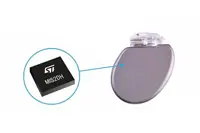 STMicroelectronics has introduced the MIS2DH, a three-axis accelerometer specifically designed for medical applications. The MIS2DH can enable functions such as activity monitoring and posture sensing to be included in a range of medical applications.
STMicroelectronics has introduced the MIS2DH, a three-axis accelerometer specifically designed for medical applications. The MIS2DH can enable functions such as activity monitoring and posture sensing to be included in a range of medical applications.
There is a growing interest in the medical world in exploring how implantable devices could help treat chronic problems such as high blood pressure, epilepsy, and tremor-related conditions. For most of these applications, an embedded accelerometer capable of measuring the activity and posture of the patient is important to manage the stimulus delivered by the implantable device and therefore to improve the effectiveness of the treatment and the wellbeing of the patient.
Anton Hofmeister, general manager of ST’s Custom MEMS Division, said: "By combining our expertise in motion-sensing with a robust set of procedures for developing, manufacturing, and testing devices aimed at applications that meet the most stringent medical regulatory requirements, ST is contributing to important progress in this field by significantly lowering the cost and time-to-market barriers."
The MIS2DH measures 2 x 2 x 1mm, operates across a voltage range of 1.71 to 3.6V and features power consumption down to 2µA in low-power mode.
Author
Tom Austin-Morgan
Source: www.newelectronics.co.uk
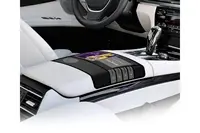 Flexible electronics specialist FlexEnable is showing the first integreated automotive application for a conformed LCD at the IAA 2015 automotive event. The demonstration will be part of a display integrating several new automotive technologies, coordinated by its EMS company Flex.
Flexible electronics specialist FlexEnable is showing the first integreated automotive application for a conformed LCD at the IAA 2015 automotive event. The demonstration will be part of a display integrating several new automotive technologies, coordinated by its EMS company Flex.
The FlexEnable demonstration is of a flexible display incorporated into a car’s A-pillar and paired with a camera attached to the wing mirror. This innovation, the company says, will offer an enhanced view of the side and rear of the vehicle, eliminating blind spots and increasing road safety.
“We are excited to be working with Flex to demonstrate our capability in organic (LCDs) at this important event,” said Chuck Milligan, FlexEnable’s CEO. “Today’s car interiors are stylish, functional and comfortable and have curved surfaces everywhere, except where constrained by rectangular, glass display panels. FlexEnable technology removes this constraint, while providing the same display quality and reliability customers have come to expect from LCDs.”
FlexEnable’s display is said to add minimal incremental thickness and weight to the frame, minimising visibility impedance, while its conformal nature provides comprehensive coverage of the A-pillar. Technology from Flex gives the display and the camera the ability to interact with the environment, allowing the driver to respond in real-time.
Previously, FlexEnable has created demonstrations – such as the console pictured – of how its technology can be formed into complex curves and irregular shapes, allowing surfaces to become intelligent and interactive
Pic: FlexEnable says its technology can be formed into complex curves and irregular shapes
Author
Graham Pitcher
Source: www.newelectronics.co.uk
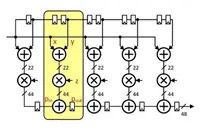 Flex Logix has extended its core FPGA logic architecture to include block RAM (BRAM) and DSP cores. According to the company, adding low latency memory and signal processing capabilities broadens the range of applications its EFLX embedded FPGA in SoC architecture can address.
Flex Logix has extended its core FPGA logic architecture to include block RAM (BRAM) and DSP cores. According to the company, adding low latency memory and signal processing capabilities broadens the range of applications its EFLX embedded FPGA in SoC architecture can address.
EFLX technology allows SoC designers to embed FPGAs into their designs, enabling key functions to be optimised or customised after the device is made. It also allows for in system upgrading.
By adding BRAM and DSP, Flex Logix expands the tool kit available to designers for this post-production flexibility. For instance, applications such as encryption, networking and signal processing require blocks of RAM to be integrated into the FPGA to provide fast local memory to implement buffers, scratchpads, FIFOs, and other low-latency memory that improves performance.
Flex Logix says its architecture can now support any amount of single or dual port RAM in any width. Along with ECC, parity or no error checking, the approach is said to offer more flexibility than is found in standalone FPGAs.
Meanwhile, Flex Logix has added an EFLX Logic core with 40 MACs with 22bit inputs and 48bit accumulation. The MACs can be combined for double precision and pipelined for high throughput. They can also be used as complex number MACs for certain DSP algorithms.
EFLX technology is targeted at TSMC’s 28HPM/C processes, with a version for being developed for TSMC’s 40LP/ULP processes. According to the company, it expects to develop a version for TSMC’s 16nm FinFET process.
Author
Graham Pitcher
Source: www.newelectronics.co.uk
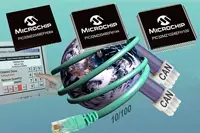 Microchip has added a new series to its PIC32MZ family of 32bit MCUs. Th 48 member PIC32MZ EF series also offers a 12bit, 18Msample/s A/D converter alongside an integrated hardware floating point unit. According to the company, the PIC32MZ EF also supports an extensive DSP instruction set.
Microchip has added a new series to its PIC32MZ family of 32bit MCUs. Th 48 member PIC32MZ EF series also offers a 12bit, 18Msample/s A/D converter alongside an integrated hardware floating point unit. According to the company, the PIC32MZ EF also supports an extensive DSP instruction set.
Designed around an Imagination MIPS M-Class core running at up to 200MHz, the EF series has up to 2Mbyte of dual panel live update flash, 512kbyte of RAM and a broad set of connectivity peripherals, including a 10/100 Ethernet MAC and dual CAN ports.
In the low cost controllerless graphics configuration, the EF series can support displays with up to WQVGA resolution. A hardware crypto engine is also available, with a random number generator and AES, 3DES, SHA, MD5 and HMAC authentication.
The 48 members of the PIC32MZ EF series are available now. Of these, 16 feature a crypto engine, 12 MCUs have 512kbyte of flash, 24 have 1Mbyte of flash and 12 have 2Mbyte of flash.
Four PIC32MZ EF development tools are also available: the PIC32MZ Embedded Connectivity with FPU EF Starter Kit; the PIC32MZ Embedded Connectivity with Floating Point Unit and Crypto Starter Kit; the PIC32MZ2048EF PIM Explorer 16 Plug In Module; and the PIC32MZ EF Audio 144pin PIM for Bluetooth® Audio Development Kit.
Depending on the features selected, the MCUs can be supplied in a 64pin QFN, a 64pin TQFP, a 100pin TQFP, a 124pin VTLA, a 144pin TQFP and a 200pin LQFP.
Author
Graham Pitcher
Source: www.newelectronics.co.uk
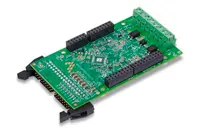 Looking to help automotive manufacturers meet stringent functional safety requirements for battery systems, Freescale has launched the MC33772, a device which can control from three to six Li-ion cells. According to the company, the device’s performance and functional safety features have been optimised for 14V Li-ion battery packs, allowing manufacturers to consider replacing traditional automotive lead-acid batteries.
Looking to help automotive manufacturers meet stringent functional safety requirements for battery systems, Freescale has launched the MC33772, a device which can control from three to six Li-ion cells. According to the company, the device’s performance and functional safety features have been optimised for 14V Li-ion battery packs, allowing manufacturers to consider replacing traditional automotive lead-acid batteries.
“Drivers face a host of issues and concerns about lead-acid batteries, many of which are caused by outside elements, like extreme temperatures, that are hard to control, causing about 100 million batteries to be replaced every year in the US alone,” said Jaime Pla, general manager of the Freescale’s Analog Driver and Energy Systems organisation. “Freescale is helping reduce those concerns, making it easier for our customers to offer an effective Li-Ion alternative to lead-acid, while meeting stringent performance and functional safety requirements across a variety of battery sizes and types.”
The MC33772, supplied in a 48pin LQFP, is said to support a range of battery chemistries, including lithium iron phosphate, lithium nickel manganese cobalt oxide, lithium titanate, and lithium polymer.
The device performs A/D conversions of the differential cell voltages and current, as well as Coulomb counting and temperature measurements. Data is transmitted through SPI or transformer isolation to an MCU for processing.
Freescale claims the part can also help to reduce the system electronics bill of materials in a range of automotive and industrial battery management applications, including 48V battery systems, high voltage hybrid and electric cars, E-bikes and energy storage systems.
Featuring accuracy, scalability and 2Mbit/s isolated communications, the MC33772 delivers an optimal balance of measurement accuracy, scalability and high speed isolated communications and can be used in a range of battery management system topologies.
The KIT33772ASP1EVB evaluation kit (pictured) is available to support product development and to highlight the chip's functionality.
Author
Graham Pitcher
Source: www.newelectronics.co.uk
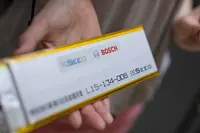 Bosch will debut a battery technology for electric cars that could be production-ready in as little as five years. In addition to its own development in the area of battery technology, Bosch now has crucial know-how in innovative solid-state cells for lithium batteries as well as exclusive patents, thanks to the acquisition of the US start-up Seeo Inc.
Bosch will debut a battery technology for electric cars that could be production-ready in as little as five years. In addition to its own development in the area of battery technology, Bosch now has crucial know-how in innovative solid-state cells for lithium batteries as well as exclusive patents, thanks to the acquisition of the US start-up Seeo Inc.
“Bosch is using its knowledge and considerable financial resources to achieve a breakthrough for electromobility,” said Dr. Volkmar Denner, the chairman of the board of management of Robert Bosch GmbH. “Solid-state cells could be a breakthrough technology. Disruptive start-up technology is meeting the broad systems knowledge and financial resources of a multinational company.”
With the new solid-state cells, Bosch sees the potential to more than double energy density by 2020, and at the same time reduce costs. Bosch says that a comparable electric car that has a driving range of 150km would be able to travel more than 300km without recharging using its solid-state cells.
By 2025, the company forecasts that roughly 15% of all new cars built worldwide to have at least a hybrid powertrain. In Europe, more than a third of all new cars will be electrically powered – the majority as plug-in hybrids. In 2014 Bosch joined GS Yuasa and Mitsubishi Corporation in establishing the joint venture Lithium Energy and Power GmbH & Co. KG, whose objective is to develop a more powerful generation of lithium-ion batteries. Seeo Inc.’s technology complements the work done so far with Bosch’s Japanese partners.
In current lithium-ion batteries, one of the reasons energy capacity is limited is because the anode consists to a large degree of graphite. Using solid-state technology, Bosch says it can manufacture the anode out of pure lithium, which increases storage capacity. In addition, the new cells function without ionic liquid, which means they are not flammable. Acquiring Seeo has provided Bosch with the first sample cells which have the potential to meet the safety and durability standards of the automotive industry.
Author
Tom Austin-Morgan
Source: www.newelectronics.co.uk

